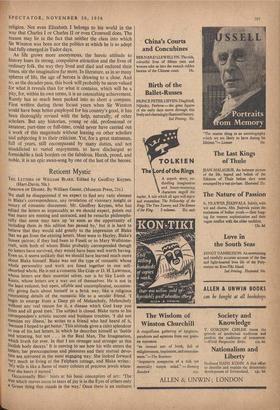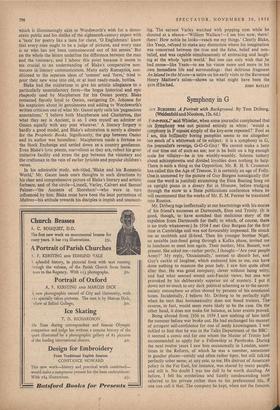Reticent Mystic
THE LEITERS OF WILLIAM BLAKE. Edited by Geoffrey Keynes. (Hart-Davis, 50s.)
ARROWS OF DESIRE. By William Gaunt. (Museum Press, 21s.)
WE shall be disappointed if we expect to find any vatic element in Blake's correspondence, any revelation of visionary insight or outcry of romantic discontent. Mr. Geoffrey Keynes, who has edited the letters as impeccably as we should expect, points out that many are missing and untraced, and he remarks philosophi- cally that some may turn up 'as soon as the opportunity of Including them in this edition has passed by,' but it is hard to believe that they would add greatly to the impression of Blake that we get from the existing letters. Most were to Hayley, Blake's Sussex patron; if they had been to Fuseli or to Mary Wollstonc- craft, with both of whom Blake probably corresponded though no letters have survived, they would have been well worth having. Even so, it seems unlikely that we should have learned much more about Blake himself. Blake was not the type of romantic whose whole personality and work are fused together in one self- absorbed whole. He is not a romantic like Gide or D. H. Lawrence, whose letters are their essential selves, nor is he like Lamb or Keats, whose letters are a way out of themselves. He is not in the least reticent, but open, affable and uncomplicated, occasion- ally giving facts about himself in a brisk way, like a religious mentioning details of the monastic life to a secular friend. 'I begin to emerge from a Deep pit of Melancholy, Melancholy Without any real reason for it, a disease which God keep you from and all good men.' The subject is closed. Blake turns to his correspondent's artistic success and business troubles. '1 did not Mention my illness,' he writes to a friend who had heard of it, because I hoped to get better.' This attitude gives a calm splendour to one of his last letters, in which he describes himself as 'feeble and tottering, but not . . . in the Real Man, The Imagination, Which liveth for ever. In that I am stronger and stronger as this foolish body decays.' It is moving to see how his wife enters the letters; her preoccupations and pleasures and their mutual devo- tion are mirrored in the most engaging way. She looked forward Very much to • living at the Felpham cottage, and Blake writes : My wife is like a flame of many colours of precious jewels when- ever she hears it named.'
Occasionally Blak - hints at his basic conception of art : 'The tree which moves sortie to tears of joy is in the Eyes of others only a Green thing that stands in the way.' Once there is an outburst which is illuminatingly akin to Wordsworth's wish for a demo- cratic public and his dislike of the eighteenth-century expert with a 'taste' for poetry like a taste for claret. '0 Englishmen! know that every man ought to be a judge of pictures, and every man is so who has not been connoisseured out of his senses.' But on the whole the letters underline the difference between the man and the visionary, and I labour this point because it seems to me crucial to an understanding of Blake's comparative non- success in literary communication. Many early Romantics, con- ditioned to the separate ideas of 'content' and 'form,' tried to pour their new wine into old, or at least ready-made, bottles.
Blake had the misfortune to give his artistic allegiance to a particularly unsatisfactory form—the bogus historical and epic rhapsody used by Macpherson for his Ossian poetry. Blake remained fiercely loyal to Ossian, castigating Dr. Johnson for his scepticism about its genuineness and adding to Wordsworth's written criticism one of what Mr. Gaunt aptly calls his 'pugnacious annotations.' I believe both Macpherson and Chatterton, that what they say is Ancient, is so. I own myself art admirer of Ossian equally with any poet whatever.' A literary forgery is hardly a good model, gnd Blake's admiration is surely a disaster for the Prophetic Books. Significantly, the gap between Ossian and its author was boundless: Macpherson made a fortune on the Stock Exchange and settled down as a country gentleman. Even Blake's lyric poems, marvellous as they are, reflect his great imitative facility and stress the gap between the visionary and the craftsman in the vein of earlier lyricists and popular children's verses.
In his admirable study, sub-titled 'Blake and his Romantic World,' Mr. Gaunt leads one's thoughts in such directions by his clear and comprehensive picture of Blake's literary and artistic forbears, and of the circle—Linnell, Varley, Calvert and Samuel Palmen—`the Ancients of Shoreham'—who were in turn influenced by him. Blake must have been the least portentotis of Ma?tres—his attitude towards his disciples is impish and unassum- ing. The earnest Varley watched with popping eyes while he shouted at a sdance—William Wallace!—! see him now, there! there! How noble he looks—reach me my things.' Clearly Blake, like Yeats, refused to make any distinction where his imagination was concerned between the true and the false, belief and non- belief, and was capable simultaneously of embracing and laugh- ing at the whole p 'spirit world.' But one can only wish that he bad come—like Yeats—to see his vision more and more in his own immediate life and surroundings ; that delirious fragment An Island in the Moon—a satire on his early visits to the Reverend Henry Mathew's salon—shows us what might have been the



















































 Previous page
Previous page